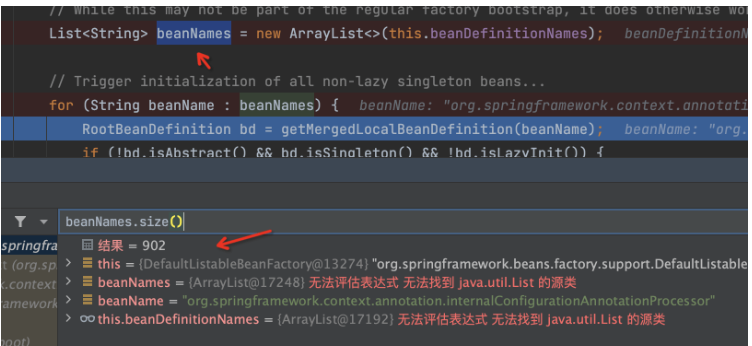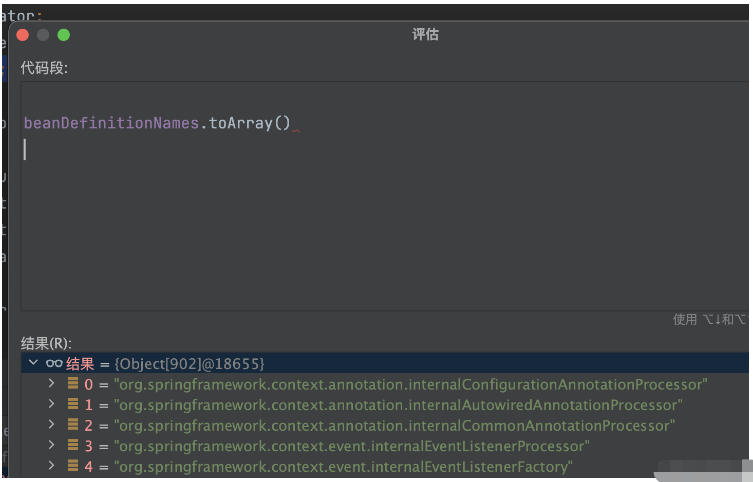жӮЁеҘҪпјҢзҷ»еҪ•еҗҺжүҚиғҪдёӢи®ўеҚ•е“ҰпјҒ
жӮЁеҘҪпјҢзҷ»еҪ•еҗҺжүҚиғҪдёӢи®ўеҚ•е“ҰпјҒ
иҝҷзҜҮвҖңSpringBoot beanеҰӮдҪ•жҹҘиҜўеҠ иҪҪйЎәеәҸвҖқж–Үз« зҡ„зҹҘиҜҶзӮ№еӨ§йғЁеҲҶдәәйғҪдёҚеӨӘзҗҶи§ЈпјҢжүҖд»Ҙе°Ҹзј–з»ҷеӨ§е®¶жҖ»з»“дәҶд»ҘдёӢеҶ…е®№пјҢеҶ…е®№иҜҰз»ҶпјҢжӯҘйӘӨжё…жҷ°пјҢе…·жңүдёҖе®ҡзҡ„еҖҹйүҙд»·еҖјпјҢеёҢжңӣеӨ§е®¶йҳ…иҜ»е®ҢиҝҷзҜҮж–Үз« иғҪжңүжүҖ收иҺ·пјҢдёӢйқўжҲ‘们дёҖиө·жқҘзңӢзңӢиҝҷзҜҮвҖңSpringBoot beanеҰӮдҪ•жҹҘиҜўеҠ иҪҪйЎәеәҸвҖқж–Үз« еҗ§гҖӮ
SpringBoot bean еҠ иҪҪйЎәеәҸеҰӮдҪ•жҹҘзңӢпјҢжғізңӢеҠ иҪҪдәҶе“ӘдәӣbeanпјҢ иҝҷдәӣbeanзҡ„еҠ иҪҪйЎәеәҸжҳҜд»Җд№Ҳпјҹ
е®һйҷ…еҠ иҪҪйЎәеәҸдёҚеҸ—жҺ§еҲ¶пјҢдҪҶдјҡжңүдёҖдәӣеӨ§зҡ„еҺҹеҲҷпјҡ
1гҖҒжҢүз…§еӯ—жҜҚйЎәеәҸеҠ иҪҪпјҲеҗҢдёҖж–Ү件еӨ№дёӢжҢүз…§еӯ—жҜҚж•°еәҸпјӣдёҚеҗҢж–Ү件еӨ№дёӢпјҢе…ҲжҢүз…§ж–Ү件еӨ№е‘ҪеҗҚзҡ„еӯ—жҜҚйЎәеәҸеҠ иҪҪпјү
2гҖҒдёҚеҗҢзҡ„beanеЈ°жҳҺж–№ејҸдёҚеҗҢзҡ„еҠ иҪҪж—¶жңәпјҢйЎәеәҸжҖ»з»“пјҡ@ComponentScan > @Import > @Bean
иҝҷйҮҢзҡ„ComponentScanжҢҮ@ComponentScanеҸҠе…¶еӯҗжіЁи§ЈпјҢBeanжҢҮзҡ„жҳҜ@configuration + @bean
еҗҢж—¶йңҖиҰҒжіЁж„Ҹзҡ„жҳҜпјҡ
пјҲ1пјүComponentеҸҠе…¶еӯҗжіЁи§Јз”іжҳҺзҡ„beanжҳҜжҢүз…§еӯ—жҜҚйЎәеәҸеҠ иҪҪзҡ„
пјҲ2пјү@configuration + @beanжҳҜжҢүз…§е®ҡд№үзҡ„йЎәеәҸдҫқж¬ЎеҠ иҪҪзҡ„
пјҲ3пјү@importзҡ„йЎәеәҸпјҢе°ұжҳҜbeanзҡ„еҠ иҪҪйЎәеәҸ
пјҲ4пјүеңЁxmlдёӯпјҢйҖҡиҝҮ<bean id="">ж–№ејҸеЈ°жҳҺзҡ„beanд№ҹжҳҜжҢүз…§д»Јз Ғзҡ„зј–еҶҷйЎәеәҸдҫқж¬ЎеҠ иҪҪзҡ„
пјҲ5пјүеҗҢдёҖзұ»дёӯеҠ иҪҪйЎәеәҸпјҡConstructor >> @Autowired >> @PostConstruct >> @Bean
пјҲ6пјүеҗҢдёҖзұ»дёӯеҠ иҪҪйЎәеәҸпјҡйқҷжҖҒеҸҳйҮҸ / йқҷжҖҒд»Јз Ғеқ— >> жһ„йҖ д»Јз Ғеқ— >> жһ„йҖ ж–№жі•пјҲйңҖиҰҒзү№еҲ«жіЁж„Ҹзҡ„жҳҜйқҷжҖҒд»Јз Ғеқ—зҡ„жү§иЎҢ并дёҚжҳҜдјҳе…ҲжүҖжңүзҡ„beanеҠ иҪҪпјҢеҸӘжҳҜеңЁеҗҢдёҖдёӘзұ»дёӯпјҢйқҷжҖҒд»Јз Ғеқ—дјҳе…ҲеҠ иҪҪпјү
е…ҘеҸЈпјҡ
public class TestApplication {
public static void main(String[] args) {
try {
SpringApplication.run(TestApplication.class, args);
LOGGER.info("SpringBoot Application Start!!!");
} catch (Throwable e) {
throw e;
}
}
}е…¶дёӯ йҮҢйқўзҡ„runж–№жі•дёәпјҡ
public ConfigurableApplicationContext run(String... args) {
long startTime = System.nanoTime();
DefaultBootstrapContext bootstrapContext = createBootstrapContext();
ConfigurableApplicationContext context = null;
configureHeadlessProperty();
SpringApplicationRunListeners listeners = getRunListeners(args);
listeners.starting(bootstrapContext, this.mainApplicationClass);
try {
ApplicationArguments applicationArguments = new DefaultApplicationArguments(args);
ConfigurableEnvironment environment = prepareEnvironment(listeners, bootstrapContext, applicationArguments);
configureIgnoreBeanInfo(environment);
Banner printedBanner = printBanner(environment);
context = createApplicationContext();
context.setApplicationStartup(this.applicationStartup);
prepareContext(bootstrapContext, context, environment, listeners, applicationArguments, printedBanner);
**refreshContext**(context);
afterRefresh(context, applicationArguments);
Duration timeTakenToStartup = Duration.ofNanos(System.nanoTime() - startTime);
if (this.logStartupInfo) {
new StartupInfoLogger(this.mainApplicationClass).logStarted(getApplicationLog(), timeTakenToStartup);
}
listeners.started(context, timeTakenToStartup);
callRunners(context, applicationArguments);
}
catch (Throwable ex) {
handleRunFailure(context, ex, listeners);
throw new IllegalStateException(ex);
}
try {
Duration timeTakenToReady = Duration.ofNanos(System.nanoTime() - startTime);
listeners.ready(context, timeTakenToReady);
}
catch (Throwable ex) {
handleRunFailure(context, ex, null);
throw new IllegalStateException(ex);
}
return context;
}refreshContext(context);
private void refreshContext(ConfigurableApplicationContext context) {
if (this.registerShutdownHook) {
shutdownHook.registerApplicationContext(context);
}
**refresh**(context);
}AbstractApplicationContext#refresh
然еҗҺзңӢеҖ’数第дәҢиЎҢпјҡfinishBeanFactoryInitialization(beanFactory);
org.springframework.context.support.AbstractApplicationContext#refresh
@Override
public void refresh() throws BeansException, IllegalStateException {
synchronized (this.startupShutdownMonitor) {
StartupStep contextRefresh = this.applicationStartup.start("spring.context.refresh");
// Prepare this context for refreshing.
prepareRefresh();
// Tell the subclass to refresh the internal bean factory.
ConfigurableListableBeanFactory beanFactory = obtainFreshBeanFactory();
// Prepare the bean factory for use in this context.
prepareBeanFactory(beanFactory);
// Allows post-processing of the bean factory in context subclasses.
postProcessBeanFactory(beanFactory);
StartupStep beanPostProcess = this.applicationStartup.start("spring.context.beans.post-process");
// Invoke factory processors registered as beans in the context.
invokeBeanFactoryPostProcessors(beanFactory);
// Register bean processors that intercept bean creation.
registerBeanPostProcessors(beanFactory);
beanPostProcess.end();
// Initialize message source for this context.
initMessageSource();
// Initialize event multicaster for this context.
initApplicationEventMulticaster();
// Initialize other special beans in specific context subclasses.
onRefresh();
// Check for listener beans and register them.
registerListeners();
// Instantiate all remaining (non-lazy-init) singletons.
**finishBeanFactoryInitialization(beanFactory);**
// Last step: publish corresponding event.
finishRefresh();
}finishBeanFactoryInitialization(beanFactory)
然еҗҺзңӢжңҖеҗҺдёҖиЎҢпјҡbeanFactory.preInstantiateSingletons();
protected void finishBeanFactoryInitialization(ConfigurableListableBeanFactory beanFactory) {
// Initialize conversion service for this context.
if (beanFactory.containsBean(CONVERSION_SERVICE_BEAN_NAME) &&
beanFactory.isTypeMatch(CONVERSION_SERVICE_BEAN_NAME, ConversionService.class)) {
beanFactory.setConversionService(
beanFactory.getBean(CONVERSION_SERVICE_BEAN_NAME, ConversionService.class));
}
// Register a default embedded value resolver if no BeanFactoryPostProcessor
// (such as a PropertySourcesPlaceholderConfigurer bean) registered any before:
// at this point, primarily for resolution in annotation attribute values.
if (!beanFactory.hasEmbeddedValueResolver()) {
beanFactory.addEmbeddedValueResolver(strVal -> getEnvironment().resolvePlaceholders(strVal));
}
// Initialize LoadTimeWeaverAware beans early to allow for registering their transformers early.
String[] weaverAwareNames = beanFactory.getBeanNamesForType(LoadTimeWeaverAware.class, false, false);
for (String weaverAwareName : weaverAwareNames) {
getBean(weaverAwareName);
}
// Stop using the temporary ClassLoader for type matching.
beanFactory.setTempClassLoader(null);
// Allow for caching all bean definition metadata, not expecting further changes.
beanFactory.freezeConfiguration();
// Instantiate all remaining (non-lazy-init) singletons.
**beanFactory.preInstantiateSingletons();**
}beanFactory.preInstantiateSingletons()
еңЁиҝҷйҮҢдјҡеҜ№ beanDefinitionNames иҝӣиЎҢйҒҚеҺҶпјҢ然еҗҺиҝӣиЎҢ beanзҡ„е®һдҫӢеҢ– е’Ң з»„иЈ…
еӣ жӯӨиҝҷйҮҢзҡ„ beanDefinitionNames иҝҷдёӘеҲ—иЎЁеҶіе®ҡдәҶbean зҡ„ жіЁеҶҢйЎәеәҸгҖӮ
org.springframework.beans.factory.support.DefaultListableBeanFactory#preInstantiateSingletons
@Override
public void preInstantiateSingletons() throws BeansException {
if (logger.isTraceEnabled()) {
logger.trace("Pre-instantiating singletons in " + this);
}
// Iterate over a copy to allow for init methods which in turn register new bean definitions.
// While this may not be part of the regular factory bootstrap, it does otherwise work fine.
**List<String> beanNames = new ArrayList<>(this.beanDefinitionNames);**
// Trigger initialization of all non-lazy singleton beans...
for (String beanName : beanNames) {
RootBeanDefinition bd = getMergedLocalBeanDefinition(beanName);
if (!bd.isAbstract() && bd.isSingleton() && !bd.isLazyInit()) {
if (isFactoryBean(beanName)) {
Object bean = getBean(FACTORY_BEAN_PREFIX + beanName);
if (bean instanceof FactoryBean) {
FactoryBean<?> factory = (FactoryBean<?>) bean;
boolean isEagerInit;
if (System.getSecurityManager() != null && factory instanceof SmartFactoryBean) {
isEagerInit = AccessController.doPrivileged(
(PrivilegedAction<Boolean>) ((SmartFactoryBean<?>) factory)::isEagerInit,
getAccessControlContext());
}
else {
isEagerInit = (factory instanceof SmartFactoryBean &&
((SmartFactoryBean<?>) factory).isEagerInit());
}
if (isEagerInit) {
getBean(beanName);
}
}
}
else {
getBean(beanName);
}
}
}
// Trigger post-initialization callback for all applicable beans...
for (String beanName : beanNames) {
Object singletonInstance = getSingleton(beanName);
if (singletonInstance instanceof SmartInitializingSingleton) {
StartupStep smartInitialize = this.getApplicationStartup().start("spring.beans.smart-initialize")
.tag("beanName", beanName);
SmartInitializingSingleton smartSingleton = (SmartInitializingSingleton) singletonInstance;
if (System.getSecurityManager() != null) {
AccessController.doPrivileged((PrivilegedAction<Object>) () -> {
smartSingleton.afterSingletonsInstantiated();
return null;
}, getAccessControlContext());
}
else {
smartSingleton.afterSingletonsInstantiated();
}
smartInitialize.end();
}
}
}
еҰӮжһңдёҚиғҪзңӢпјҢеғҸеӣҫдёӯдёҖж ·пјҢдёҚиғҪжүҫеҲ°java.util.listиҝҷдёӘзұ»пјҢеҸҜд»ҘдҪҝз”ЁдёӢйқўиҝҷдёӘж–№ејҸпјҢдәІжөӢжңүж•Ҳпјҡ
beanDefinitionNames.toArray()

еҗҺйқўзҡ„beanе°ұдёҚеұ•зӨәйЎәеәҸдәҶгҖӮж„ҹе…ҙи¶Јзҡ„иҜ»иҖ…еҸҜд»ҘзңӢиҮӘе·ұspringBootйЎ№зӣ®зҡ„гҖӮ
beanDefinitionNames еҲ—иЎЁеҰӮдҪ•жқҘзҡ„е‘ўпјҹ
зӯ”жЎҲжҳҜ ConfigurationClassPostProcessor йҖҡиҝҮжү«жҸҸ д»Јз Ғ+жіЁи§Јз”ҹжҲҗзҡ„пјҢи®Іbean жү«жҸҸи§ЈжһҗжҲҗ beanDefinition, еҗҢж—¶жҠҠ beanе®ҡд№үпјҢbeanDefinitionпјҢжіЁеҶҢеҲ° BeanDefinitionRegistryпјҢ ж•…жңүдәҶbeanDefinitionNames listгҖӮ
д»ҘдёҠе°ұжҳҜе…ідәҺвҖңSpringBoot beanеҰӮдҪ•жҹҘиҜўеҠ иҪҪйЎәеәҸвҖқиҝҷзҜҮж–Үз« зҡ„еҶ…е®№пјҢзӣёдҝЎеӨ§е®¶йғҪжңүдәҶдёҖе®ҡзҡ„дәҶи§ЈпјҢеёҢжңӣе°Ҹзј–еҲҶдә«зҡ„еҶ…е®№еҜ№еӨ§е®¶жңүеё®еҠ©пјҢиӢҘжғідәҶи§ЈжӣҙеӨҡзӣёе…ізҡ„зҹҘиҜҶеҶ…е®№пјҢиҜ·е…іжіЁдәҝйҖҹдә‘иЎҢдёҡиө„и®Ҝйў‘йҒ“гҖӮ
е…ҚиҙЈеЈ°жҳҺпјҡжң¬з«ҷеҸ‘еёғзҡ„еҶ…е®№пјҲеӣҫзүҮгҖҒи§Ҷйў‘е’Ңж–Үеӯ—пјүд»ҘеҺҹеҲӣгҖҒиҪ¬иҪҪе’ҢеҲҶдә«дёәдё»пјҢж–Үз« и§ӮзӮ№дёҚд»ЈиЎЁжң¬зҪ‘з«ҷз«ӢеңәпјҢеҰӮжһңж¶үеҸҠдҫөжқғиҜ·иҒ”зі»з«ҷй•ҝйӮ®з®ұпјҡis@yisu.comиҝӣиЎҢдёҫжҠҘпјҢ并жҸҗдҫӣзӣёе…іиҜҒжҚ®пјҢдёҖз»ҸжҹҘе®һпјҢе°Ҷз«ӢеҲ»еҲ йҷӨж¶үе«ҢдҫөжқғеҶ…е®№гҖӮ